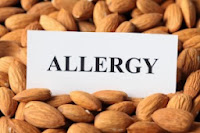Almond allergy what to do?
With a peanut or almond allergy, even a tiny amount may cause an allergic reaction in some people. Some places you find nuts, like nut butters and nut breads, are not surprising. Others, like sauces and gravies, may be.
There's no definitive treatment for almond and peanut allergy, but desensitization is showing promise. Desensitization involves giving children with peanut allergies increasing doses of peanut flour or peanut extract over time. Studies have shown promise in desensitizing children to peanuts. More study is needed.
Allergic reactions may be mild. This can be in the form of rash and/or watery eyes and congestion. The reaction may also be moderate such as rash and hives, itchiness and/or difficulty breathing. A severe reaction however, consists of abdominal pains, vomiting and strenuous breathing. A severe reaction to almonds may occur such as the unexpected incapability to breathe.


